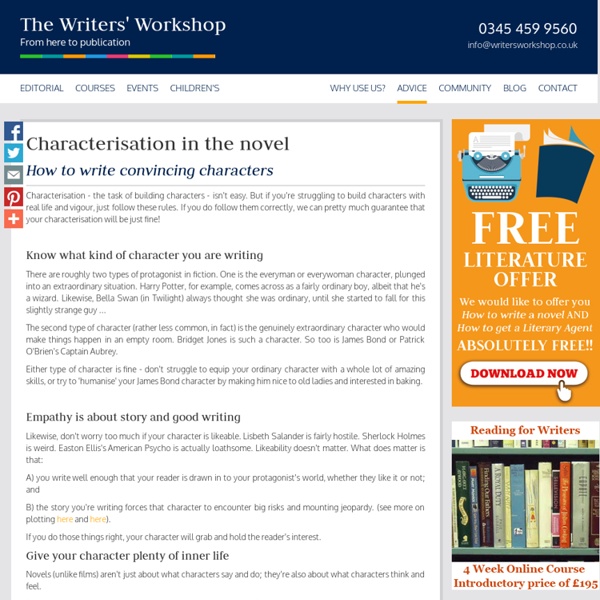The Inner Struggle: Guides for Using Inner Conflict That Make Sense
By Janice Hardy, @Janice_Hardy I sat in on an amazing workshop while I was at RWA that made something typically vague very clear and applicable. Michael Hague's Using Inner Conflict to Create Powerful Love Stories.
Character Questionnaires - Get to Know Your Characters
Receive more writing tips and advice (along with special offers and other Gotham news). One of the best ways to get to know your characters is to ask questions about them. Many writers do this as a kind of homework before they actually start writing a story.
Point of View in Creative Nonfiction
I read a lot of novels, and poetry, and even the occasional screenplay/drama. I enjoy them; I learn from them; I find them delicate, and robust, and powerful, and skillful and all the things that make good writing. BUT when I want to really understand something, when I want to feel it in the center of my chest, when I want my cheeks to be rasped with the reality of life, I turn to creative nonfiction. There’s just something about the authenticity of the writer’s perspective there that makes me connect more fully. I’ve been trying to articulate the difference in connection I feel between fiction and nonfiction ever since my friend @karriehiggins were talking about it on Twitter the other night. We were discussing ownership in writing – as in who “owns” their perspective more?
Sleep learning is possible: Associations formed when asleep remained intact when awake
Is sleep learning possible? A new Weizmann Institute study appearing August 26 in Nature Neuroscience has found that if certain odors are presented after tones during sleep, people will start sniffing when they hear the tones alone -- even when no odor is present -- both during sleep and, later, when awake. In other words, people can learn new information while they sleep, and this can unconsciously modify their waking behavior. Sleep-learning experiments are notoriously difficult to conduct. For one thing, one must be sure that the subjects are actually asleep and stay that way during the "lessons."
Creating Stunning Character Arcs, Pt. 1: Can You Structure Characters?
What if there were a sure-fire secret to creating stunning character arcs? Would you be interested in discovering it? If you care about connecting with readers, grabbing hold of their emotions, and creating stories that will resonate with them on a level deeper than mere entertainment, then the answer has to be a resounding yes!
6 Ways to Make Sure Your Reader’s Brain Syncs with Your Protagonist’s Brain
photo by Andres Musta via Flickr Because here’s the thing: it’s not fiction. It’s fact.
25 Things You Should Know About Character
Previous iterations of the “25 Things” series: 25 Things Every Writer Should Know 25 Things You Should Know About Storytelling And now… Here you’ll find the many things I believe — at this moment!
Give Your Writing More “Body”
This month’s book review is an overview of my favorite “dead body” books. Whether you are writing a mystery, suspense, action, or any sort of fiction, these are excellent tools for getting the details right, plus they make for terrific Halloween reading. Another way you can use these books is as a brainstorming tool. It’s amazing what paths of thinking and creativity will open for you as you turn the pages. When you research with these books (as opposed to the web) no gruesome or sensationalistic photos will take you by surprise and keep you up nights.
Timeline Platform
Featured Customers MyHeritage.com is a world-leading family social nework. Its 50 million users create family trees, share family photos and organize their genealogical information online. MyHeritage.com has cooperated with AllofMe to leverage the AllofMe platform for helping users view and compare their family photos and events in a super-cool, fun-to-use, chronological timeline.
Planning a Novel: Character Arc In A Nutshell
It’s NaNoWriMo Season, and that means a ton of writers are planning their novels. Or, at the very least (in the case of you pantsers) thinking about their novel. Whether you plot or pants, if you don’t want to end up in No Man’s Land halfway to 50K, it is often helpful to have a solid foundation of ideas about your book.
5 Tips on How to Write From the Opposite Gender | Miss Literati
Do you have male characters in your novel? Do you find it hard to really connect with them? They play video games, go outside, do sports, eat constantly, sleep all the time, and are major pranksters! Except not every guy is like that, just like not every girl likes dressing up, going shopping, doing her hair, and reading the latest teen magazine. So how can you, a girl, really establish a believable character from the opposite gender?
Physical Descriptions - List of Hair Colors
Hair Color List (Note: an updated and expanded version of this list appears in my 15K-word book How to Describe Hair and Skin. See below.) [First, my profound apologies to the vast majority of readers who don't steal content, but I have to state the following. This article and all content on this website belongs to Val Kovalin, copyright © Obsidianbookshelf.com, except where noted. Unauthorized use and/or duplication of this material without written permission from Val Kovalin is strictly prohibited. Excerpts and links may be used, provided that full and clear credit is given to Val Kovalin and Obsidianbookshelf.com with a return link to the original content.]



